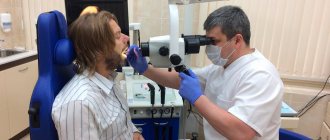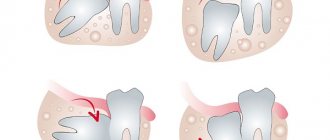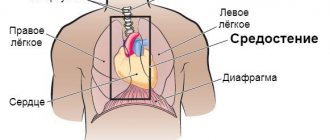Content:
- Why do the roots of teeth become exposed?
- How to understand that the dental neck is exposed
- How dangerous is the condition?
- What to do if the necks of your teeth are exposed
- Gumplasty
If the tooth is healthy, the root and neck are tightly covered with gum.
Then the smile looks aesthetically pleasing, and the person is not bothered by any discomfort. But under the influence of a number of unfavorable factors, recession of the gum tissue can occur. If they drop, the neck of the tooth is exposed. As a result, the condition of the dentogingival apparatus worsens. The unit gradually becomes mobile. If appropriate measures are not taken, it will fall out. Dentists treat exposed teeth. A person cannot fix the problem on his own. Therefore, if this condition affects you, be sure to make an appointment with your doctor . Do not try to restore the primary volume of the gums using folk recipes. This will not lead to anything good. In this case, you will miss time, which means the course of the disease will worsen.
What actions at home can aggravate the problem?
If there is toothache and an exposed nerve, not everyone tries to see a doctor right away. Some resort to all sorts of pain relief methods. But here you need to know when to stop and not cause even more harm to your health. Let's consider what actions can have negative consequences:
- warming up the inflamed area: this will further increase the pain and cause inflammation to progress due to the rush of blood, as well as the spread of bacteria along with blood flow to nearby tissues,
- rinsing with hot solutions and decoctions: hot water can injure the mucous membranes and lead to exactly the same effect as warming procedures,
- applying a crushed aspirin tablet to the tooth: this drug, when applied externally, can cause severe burns and irritation of the mucous membrane,
- lotions with alcohol tinctures: similar to aspirin, they will dry out and damage the mucous membrane,
- being in a horizontal position: when the head is at the same level with the body, blood flow and pressure increase, due to which the pain only becomes stronger. To make the situation easier, on the contrary, you need to place your head higher than your body. You can use a high pillow for this.
Why do the roots of teeth become exposed?
There are various reasons why tooth roots become exposed. Among them:
- Poor oral hygiene. A person brushes his teeth poorly and irregularly, uses too hard a brush and poor-quality toothpaste.
- Oral diseases. The most dangerous provocateurs: periodontitis, periodontal disease, progressive cervical caries, atrophic gingivitis. With all these pathologies, soft tissues begin to atrophy and sag. Their volume decreases. Then the surface of the dental crown begins to look unusually long. This indicates that the cervix has opened slightly.
- Bite disorders. Some types of occlusion place very strong pressure on the gums. Because of this, you can observe exposed necks of the teeth. To eliminate the problem, it is necessary to carry out competent orthodontic treatment using mouth guards, braces or other leveling systems.
- Age-related changes. Often the disorder occurs in people over 55-60 years of age. It is associated with natural wear and tear of teeth and deterioration of their condition, a slowdown in metabolic processes and poor supply of oral tissues with the nutrients they need.
- Having a piercing in the mouth. A metal earring scratches the gums, puts pressure on them, which is why they slowly “sag.”
- Thyroid diseases, diabetes mellitus, severe autoimmune pathologies. Often, because of them, the local blood supply is disrupted, which leads to exposure of the roots of the teeth.
Hormonal disorders, bruxism, anatomical features of the location of the frenulum - all this can also provoke a problem. If you are unsure why your gums are receding, consult your dentist. He will quickly determine the cause of the violation.
Acute pulpitis
Acute pulpitis, as we have already said, is characterized by severe toothaches that occur WITHOUT a reason and intensify at night. The main symptomatic difference between acute pulpitis and caries is that pain in deep caries is always associated with an irritant, and stops when the action of the irritant is interrupted. The pain associated with pulpitis is pulsating, not associated with impact on the tooth, is difficult to relieve with tablets, and radiates to the ear, jaw, and temple. It is difficult for the patient to determine which tooth hurts; usually he complains that half of the jaw hurts.
There are several forms of acute pulpitis, depending on the location and manifestations of the inflammatory process:
| Forms of acute pulpitis | What is the difference? | Nature of pain |
| Focal | Inflammation of the coronal part of the pulp | Paroxysmal severe pain that radiates to the jaw. |
| Diffuse | Inflammation of the entire pulp | The pain lasts 10-15 minutes with a break of several hours. Symptoms are worse when lying down. |
| Serous | Very severe inflammation in an advanced stage | Continuous throbbing pain. |
| Purulent | Pus forms in the dental canals | Under the influence of warm food or drink, the pain intensifies, and cold food relieves it. |
How to understand that the dental neck is exposed
The sooner a person notices a pathological condition, the better. In the early stages, it is much easier to correct it. Among the main symptoms:
- Lengthening the surface of the crown of the tooth. The unit begins to look very long, which is most often unnatural.
- Increase in interdental spaces. The teeth are designed in such a way that their width gradually decreases towards the gums. When the gums recede, this property becomes clearly visible. Subjectively, a person may notice that food debris has begun to accumulate between his teeth. He has to floss more often.
- Increased tooth sensitivity. Units begin to react very sharply to temperature changes, sweet, salty, sour and spicy foods.
- Gums often bleed. With atrophy of soft tissues, their condition worsens, the walls become thinner. Any inaccurate movement during hygiene procedures or chewing solid foods causes damage to them, which is manifested by bleeding.
- The appearance of the gums changes. It brightens or turns blue, sags in comparison with healthy surrounding tissues. It often looks swollen and inflamed. May hurt when pressed.
- There is an unpleasant odor from the mouth. When gums atrophy, deep gum pockets often form. They are the optimal place for the accumulation of small food debris and the proliferation of pathogenic microorganisms. It is impossible to clean them with a regular toothbrush. Therefore, no matter how much a person brushes his teeth, he cannot get rid of the fetid odor.
Chronic pulpitis
Chronic pulpitis occurs if acute pulpitis is not treated. At some stage, acute pain subsides, but destructive processes in the pulp continue. The infection lies dormant and makes itself felt by periodic “shots” in the presence of hot, cold, sour, and sweet foods. Pain occurs when pressing on a tooth. At any moment, acute inflammation may begin again or the disease may be aggravated by a new complication.
Chronic pulpitis also has several forms:
| Forms of chronic pulpitis | Main characteristics | Nature of pain |
| Fibrous | The pulp bleeds when pressed | Short-term pain, as a reaction to cold and hot. |
| Hypertrophic | Pulp growth, which can extend beyond the open carious cavity, bleeding when eating. | There is no pain, it does not hurt when tapped, there is no reaction to irritants. |
| Gangrenous | Pulp necrosis, tooth darkening, rotten smell. | Short-term pain, as a reaction to hot food. |
Pulpitis of the wisdom tooth
Pulpitis can affect all teeth without exception. But eighth wisdom teeth have an increased risk of pulpitis. They are located far away, it is difficult to clean and treat them, so inflammation of the pulp in third molars occurs more often. Treatment of pulpitis of eights is also complicated by their inconvenient location and numerous roots. The risk of complications during endodontic treatment increases and the long-term prognosis for these teeth worsens. So in the case of acute pulpitis of a wisdom tooth, it makes sense not to treat such a tooth, but to remove it immediately.
How dangerous is the condition?
With severe exposure of the dental neck, a wedge-shaped defect develops. Then the units located in the atrophied zone take on a characteristic V-shape. Because of this, the appearance of the smile deteriorates. But the problem lies not only in the deterioration of aesthetics. As the pathology progresses, the likelihood of:
- Crown fracture. It becomes excessively long. Its size is naturally disproportionate. With severe chewing load, a crack may appear or a fracture may occur.
- Deformations and curvatures of the dentition. It is not always possible to restore its original appearance later. If this can be done, it will only be with the help of long-term orthodontic and orthopedic therapy.
- The appearance of cervical caries. This is always a very painful condition. Even a small spot leads to discomfort. To prevent the patient from experiencing pain during treatment, the doctor has to inject an anesthetic.
- Loosening and tooth loss. This is perhaps the most dangerous complication. This situation can only be corrected with the help of prosthetics. It is always expensive and difficult. In addition, if there is a choice between preserving a natural tooth and installing an artificial unit, preference should always be given to the former.
Dentists know of many cases where the tooth root was severely exposed, and then a bacterial infection soon followed. As a result, a fistula is formed, from which pus is constantly released. This condition is very dangerous. If the purulent process is not stopped in a timely manner, phlegmon, sepsis and other conditions that pose a threat to health and life may develop.
Signs of trigeminal neuralgia
A typical symptom of trigeminal neuralgia is prosopathy - facial pain. The sensation can be compared to an electric shock. Pain of a paroxysmal nature lasts 5-15 seconds and occurs abruptly. It is usually localized in the area of the lower jaw and cheekbones, but can appear in any part of the face. Neuralgia in severe form leads to partial or even complete loss of sensitivity.
Other symptoms:
- nervous eyelid tic;
- impaired coordination of movements;
- increased body temperature;
- headache;
- chills, fever;
- general weakness.
What to do if the necks of your teeth are exposed
The very first thing to do is to establish the cause of the violation. Taking into account the provoking factor, the doctor chooses an effective method of gum restoration. For example:
- A large amount of tartar was discovered, due to which the tissues became inflamed and began to “sag.” Professional oral hygiene will help. It is performed in a dental office using an ultrasonic scaler. By directing an ultrasonic wave to the location of the stones, the doctor carefully “beats” them off the surface of the dental crown. After hygiene, the condition of the affected gums quickly improves. To speed up the regeneration process, a specialist can prescribe antibiotic ointments or medicinal rinses with a strengthening solution.
- If it is established that a person brushed his teeth incorrectly, cleaned the interdental spaces with waving movements (from left to right, not from top to bottom) and used a brush that was too hard, he is taught the rules of brushing. Then cover the bare areas with restoring varnish. If necessary, the cavities that appear on the teeth are filled.
- In case of malocclusion, consultation with an orthodontist is indicated. The doctor will select an effective method for correcting occlusion. These can be night guards, plates, different types of braces.
- If the necks of the teeth are exposed due to the lack of neighboring units, it is urgent to restore the integrity of the dentition. Without this, it will not be possible to stabilize the situation.
Forms and symptoms of pulpitis
Patients usually think that the main sign of pulpitis is pain and a large carious cavity in the tooth, but this is not entirely true.
There are acute and chronic forms of pulpitis, depending on the strength of the inflammatory process affecting the pulp. Severe pain, which is often not relieved by painkillers, is characteristic of the acute form of the disease. But, if it becomes chronic, the pain subsides and practically does not bother you anymore.
As for large “holes” in a diseased tooth, the patient may not see them. Pulpitis also occurs as a result of caries hidden under a thin layer of enamel and under a previously installed filling. The pulp can become inflamed in a tooth without caries, although this happens much less frequently, due to an infection brought into the tooth with blood.
Gumplasty
In advanced cases, conservative therapy does not always help. Then doctors have to perform a surgical operation aimed at:
- restoration of a healthy and beautiful gum line;
- elimination of symptoms caused by tissue atrophy;
- preventing the unit from loosening and falling out.
Gingivoplasty is a flap operation. With its help, it is possible to build up missing tissues. The operation is performed in different ways. The most popular is to take a flap of material from the palate and transfer it to the operated area.
But, if the defect is single (that is, it relates to only one tooth), such serious intervention can be avoided. The dental surgeon simply makes two horizontal and two vertical incisions and displaces the resulting flap by transferring it. After regeneration, the operated area begins to look natural and neat.
Remember: folk remedies are not able to restore atrophied gums. Do not delay treatment at the dental clinic. This is the only way to keep your teeth intact.
Treatment of pulpitis at the GALA DENT clinic
When we talk about the treatment of pulpitis, we mean the treatment of tooth canals, or, as they also say, endodontic treatment. Its task is to first remove the infected, inflamed pulp, and then clean and disinfect the tooth canals.
You can do this in two ways:
Conservative method, preserving the “nerve” of the tooth.
This treatment method is used much less frequently, because... gives an unstable forecast. It is possible to save the pulp only if its inflammation was minor and partial, or the opening of the pulp chamber occurred spontaneously and the pulp was not inflamed at all. In this case, the doctor applies a special treatment composition to the exposed areas of the pulp, which “preserves” the nerve, creating a protective layer. After which a seal is placed on a special gasket.
Using a surgical method, with the removal of the “nerve” of the tooth - depulpation.
In this case, complete removal of the pulp can be carried out:
- “alive” - a vital way to treat pulpitis,
- after preliminary mummification of the pulp with a special preparation - a devital method of treating pulpitis.
- Our doctors prefer to treat pulpitis for our patients in 2 visits using the method of devital extirpation with removal of the mummified “nerve”.
This method does not require excessively strong anesthesia and provides a stable long-term prognosis.
On the first visit, under ANESTHESIA, the doctor cleans the tooth cavity from destroyed tissue, opens the pulp chamber and applies a special arsenic-free paste to the pulp to mummify the pulp for about 7 days. A temporary filling is placed on top.
After 7-10 days, at a second appointment, the already dead pulp is removed - depulpation is carried out, after which the tooth canals are cleaned and disinfected.
Next, the tooth canals are filled with gutta-percha and a permanent filling is installed with restoration of the chewing surface.
The quality of canal filling is controlled by x-ray.
If the crown of a tooth is severely damaged, it will need to be restored using an inlay or a crown. The prosthetic stage is very important in order to strengthen the tooth and prevent its destruction.
Prevention
If for some reason you had to depulpate a tooth, you should not think that now it will never bother you again - without proper preventive measures, the likelihood of pain is very high. To avoid complications, follow simple rules:
- Do not eat or drink for 2 hours after surgery - this will reduce the risk of infection under the filling. Smoking and drinking alcohol are not recommended for at least 24 hours after treatment.
- Take anti-inflammatory pain medications as recommended by your dentist.
- At first, try to reduce the chewing load on the pulpless tooth.
- Regular hygiene. Immediately after treatment, buy a toothpaste to reduce tooth sensitivity. In the future, brush your teeth 2 times a day, do not neglect dental floss and mouth rinses.
- Professional hygiene. Visit your dentist at least once every six months. Make an appointment for a professional plaque and tartar cleaning once a year. To protect your teeth from adverse external influences, go through the procedure of fissure sealing, and to strengthen the enamel - remineralization or fluoridation.
And remember - everything in our body is interconnected. Don’t wait for pain – at the first signs of discomfort after dental treatment, contact your doctor immediately.
Author: Elena Kopylova Dentist-therapist, endodontist, pediatric dentist. Work experience more than 7 years. The information is for reference only. Before treatment, consultation with a doctor is necessary.











